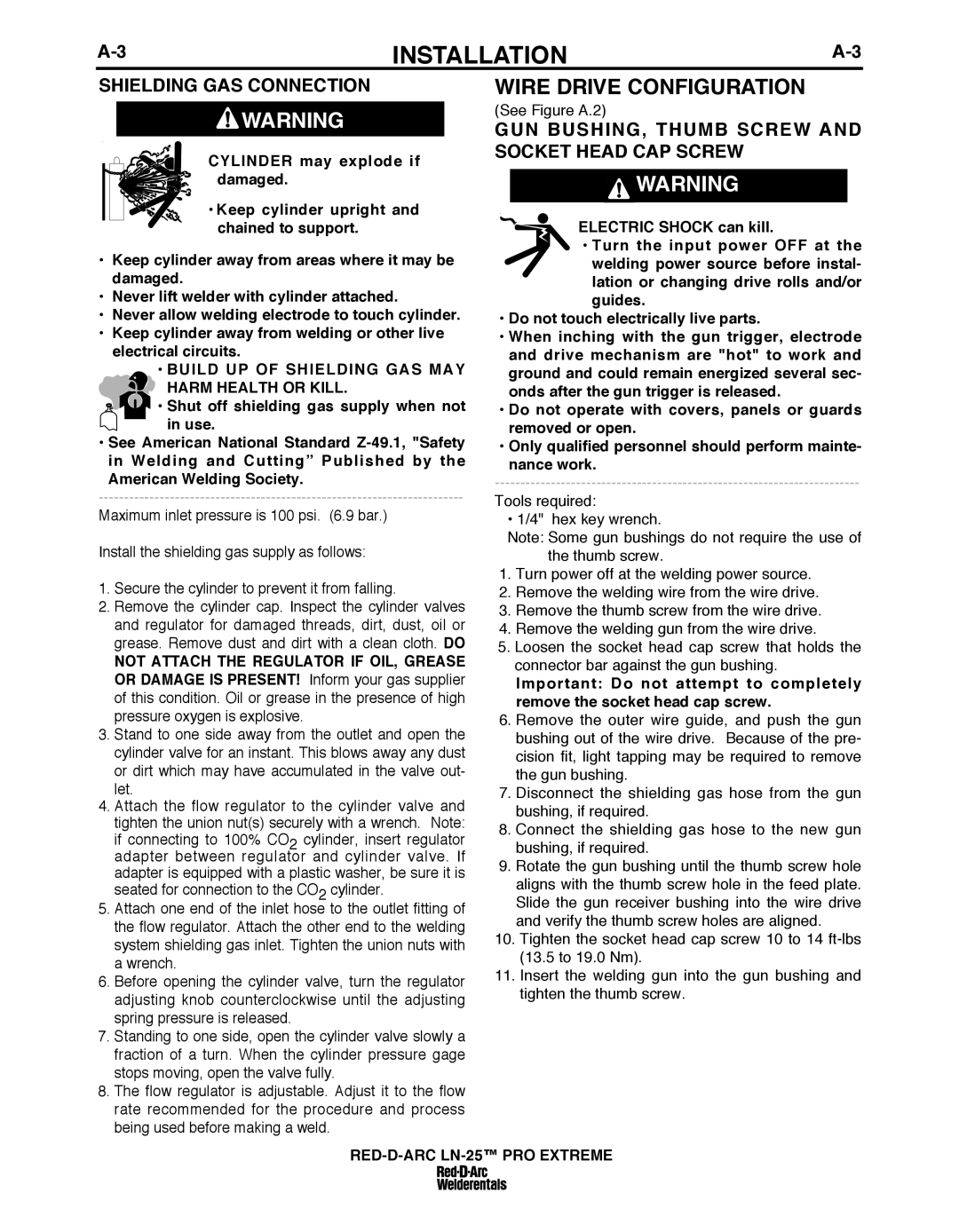
INSTALLATION | ||
|
|
|
ShIELDING GAS CONNECTION
![]() WARNING
WARNING
CYLINDER may explode if damaged.
• Keep cylinder upright and chained to support.
•Keep cylinder away from areas where it may be damaged.
•Never lift welder with cylinder attached.
•Never allow welding electrode to touch cylinder.
•Keep cylinder away from welding or other live electrical circuits.
•buILD uP OF ShIELDING GAS MAY ![]() hARM hEALTh OR KILL.
hARM hEALTh OR KILL.
• Shut off shielding gas supply when not in use.
•See American National Standard
Maximum inlet pressure is 100 psi. (6.9 bar.)
Install the shielding gas supply as follows:
1.Secure the cylinder to prevent it from falling.
2.Remove the cylinder cap. Inspect the cylinder valves and regulator for damaged threads, dirt, dust, oil or grease. Remove dust and dirt with a clean cloth. DO
NOT ATTACh ThE REGuLATOR IF OIL, GREASE OR DAMAGE IS PRESENT! Inform your gas supplier of this condition. Oil or grease in the presence of high pressure oxygen is explosive.
3.Stand to one side away from the outlet and open the cylinder valve for an instant. This blows away any dust or dirt which may have accumulated in the valve out- let.
4.Attach the flow regulator to the cylinder valve and tighten the union nut(s) securely with a wrench. Note:
if connecting to 100% CO2 cylinder, insert regulator adapter between regulator and cylinder valve. If adapter is equipped with a plastic washer, be sure it is seated for connection to the CO2 cylinder.
5.Attach one end of the inlet hose to the outlet fitting of the flow regulator. Attach the other end to the welding system shielding gas inlet. Tighten the union nuts with a wrench.
6.Before opening the cylinder valve, turn the regulator adjusting knob counterclockwise until the adjusting spring pressure is released.
7.Standing to one side, open the cylinder valve slowly a fraction of a turn. When the cylinder pressure gage stops moving, open the valve fully.
8.The flow regulator is adjustable. Adjust it to the flow rate recommended for the procedure and process being used before making a weld.
WIRE DRIVE CONFIGuRATION
(See Figure A.2)
GuN buShING, ThuMb SCREW AND SOCKET hEAD CAP SCREW
![]() WARNING
WARNING
ELECTRIC ShOCK can kill.
•Turn the input power OFF at the welding power source before instal- lation or changing drive rolls and/or guides.
•Do not touch electrically live parts.
•When inching with the gun trigger, electrode and drive mechanism are "hot" to work and ground and could remain energized several sec- onds after the gun trigger is released.
•Do not operate with covers, panels or guards removed or open.
•Only qualified personnel should perform mainte- nance work.
Tools required:
• 1/4" hex key wrench.
Note: Some gun bushings do not require the use of the thumb screw.
1.Turn power off at the welding power source.
2.Remove the welding wire from the wire drive.
3.Remove the thumb screw from the wire drive.
4.Remove the welding gun from the wire drive.
5.Loosen the socket head cap screw that holds the connector bar against the gun bushing.
Important: Do not attempt to completely remove the socket head cap screw.
6.Remove the outer wire guide, and push the gun bushing out of the wire drive. Because of the pre- cision fit, light tapping may be required to remove the gun bushing.
7.Disconnect the shielding gas hose from the gun bushing, if required.
8.Connect the shielding gas hose to the new gun bushing, if required.
9.Rotate the gun bushing until the thumb screw hole aligns with the thumb screw hole in the feed plate. Slide the gun receiver bushing into the wire drive and verify the thumb screw holes are aligned.
10.Tighten the socket head cap screw 10 to 14
11.Insert the welding gun into the gun bushing and tighten the thumb screw.
